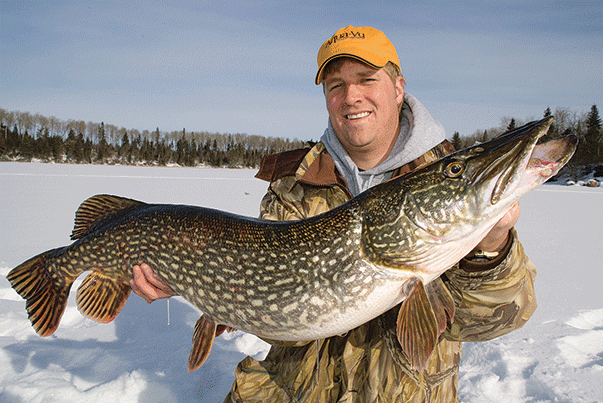Advertisement
There are a few thrills in ice fishing more exciting than hooking into a leviathan northern pike, fighting it beneath your boots, then watching wide-eyed as the beast comes slithering up through the hole and onto the ice. But for that kind of winter action, you’ve got to disregard most of what you’ve been told about where and how to catch trophy pike—especially the stuff about always fishing around the weeds.
No, for most of the winter, there are far better and faster ways to ice the northern pike of your dreams, especially in typical Canadian Shield waters.
Advertisement
Winter pike haunts
Focusing on weeds might work in shallow, small to moderate-sized lakes that are typically choked with wall-to-wall vegetation. And it might work on larger lakes at last ice when the pike are migrating toward shallow bays, coves and rivermouths to spawn. But I consistently catch enormous toothy critters all winter long in 15 to 30 feet of water over and around hard rock structures, with nary a weed stalk in sight.
This is especially true when the principal forage fish in the lake includes white suckers, smelt, ciscoes and whitefish. When these packed-with-protein forage fish are plentiful, the best places you can ice fish for pike are on the same rock humps, underwater points and shoals you typically target for winter walleye and lake trout.
Advertisement
And here’s the surprising part: the prodigious pike that inhabit these key structures use the biggest boulders as ambush points. They also cruise the edges of the structure like marauding sharks, in precisely the same way most ice anglers think the big fish patrol weedlines. In either case, it’s rare to catch a northern weighing less than double digits.
Winter pike tactics
Advertisement
Giant gators are also territorial, so on small to moderately sized structure you can typically expect to catch one, maybe two fish. And on a bigger point or reef, you might catch a few more. Rarely is it a numbers game, however, so rather than wait them out, it’s best to run-and-gun, hitting a half-dozen or more locations over the course of a typical winter’s day.
For this itinerant big-pike strategy, use a 32- to 36-inch heavy-action ice rod and a reel spooled with 14- to 17-pound-test super-line. Add a short metal leader for jigging lures, such as the largest Rapala Jigging Rap (remove the bottom treblehook) or a Williams Whitefish spoon. Also deadly is a 3⁄8- to 1/2-ounce jig tipped with a soft-plastic Hollow Belly, Swammer or Shift’R Shad swimbait closely matching the size, shape, colour and profile of your lake’s forage fish.
And speaking of forage fish, since most provinces allow anglers to use two lines while ice fishing, I normally present a large, freshly thawed whole sucker, cisco or whitefish belly attached to a quick-strike rig in the second hole. Talk about the perfect one-two punch pike presentation. Just remember that nothing beats using whatever baitfish the northerns are already keyed in on. You’d think that a hungry pike attuned to eating ciscoes would also smack a succulent sucker, but think again.
Finally, always keep your lure, or dead bait, either in front of the fish or above them at all times. Pike are perhaps the most proficient predator when it comes to using available cover, including the underside of the ice, to conceal themselves and silhouette their prey. Now, game on.

